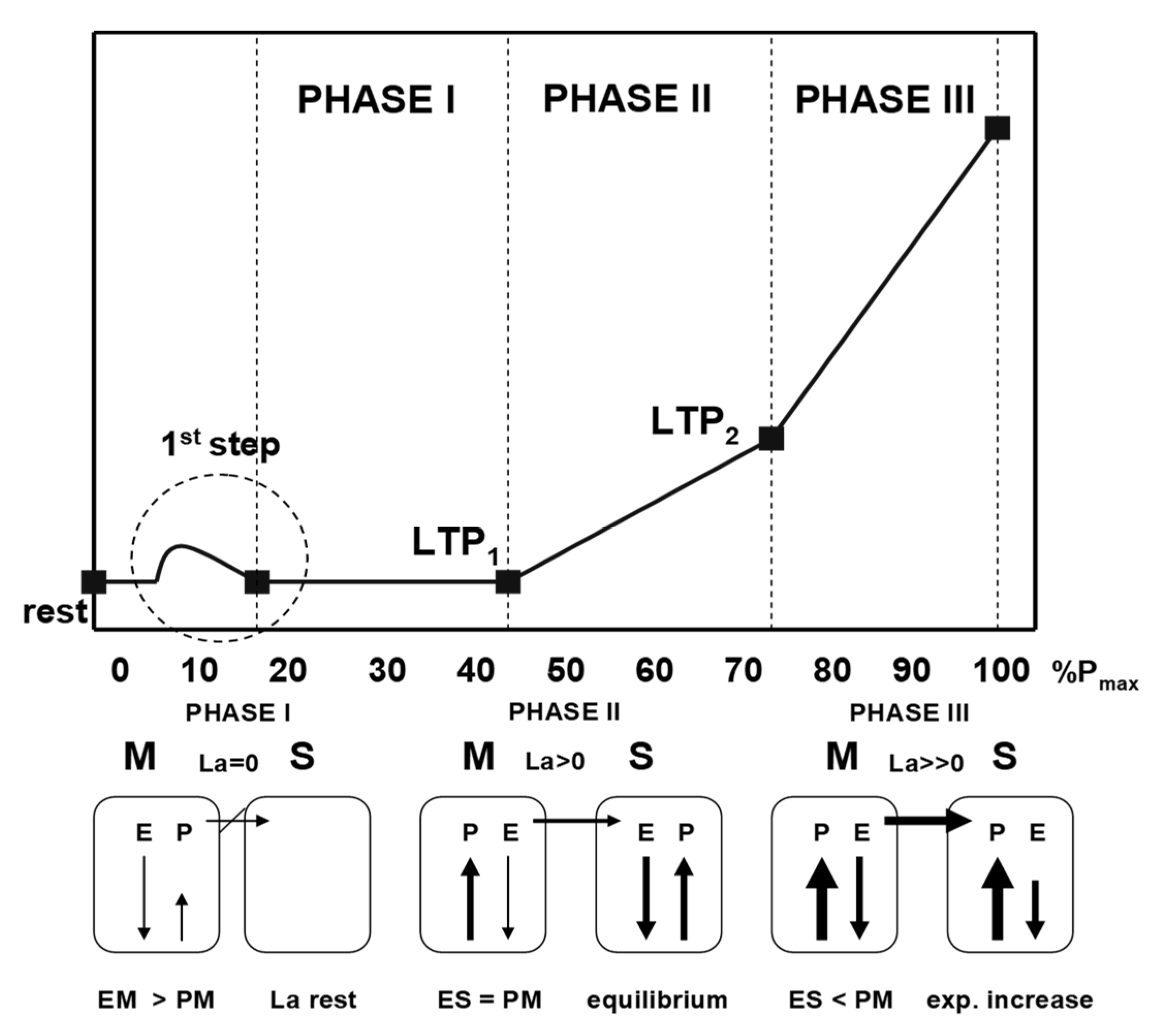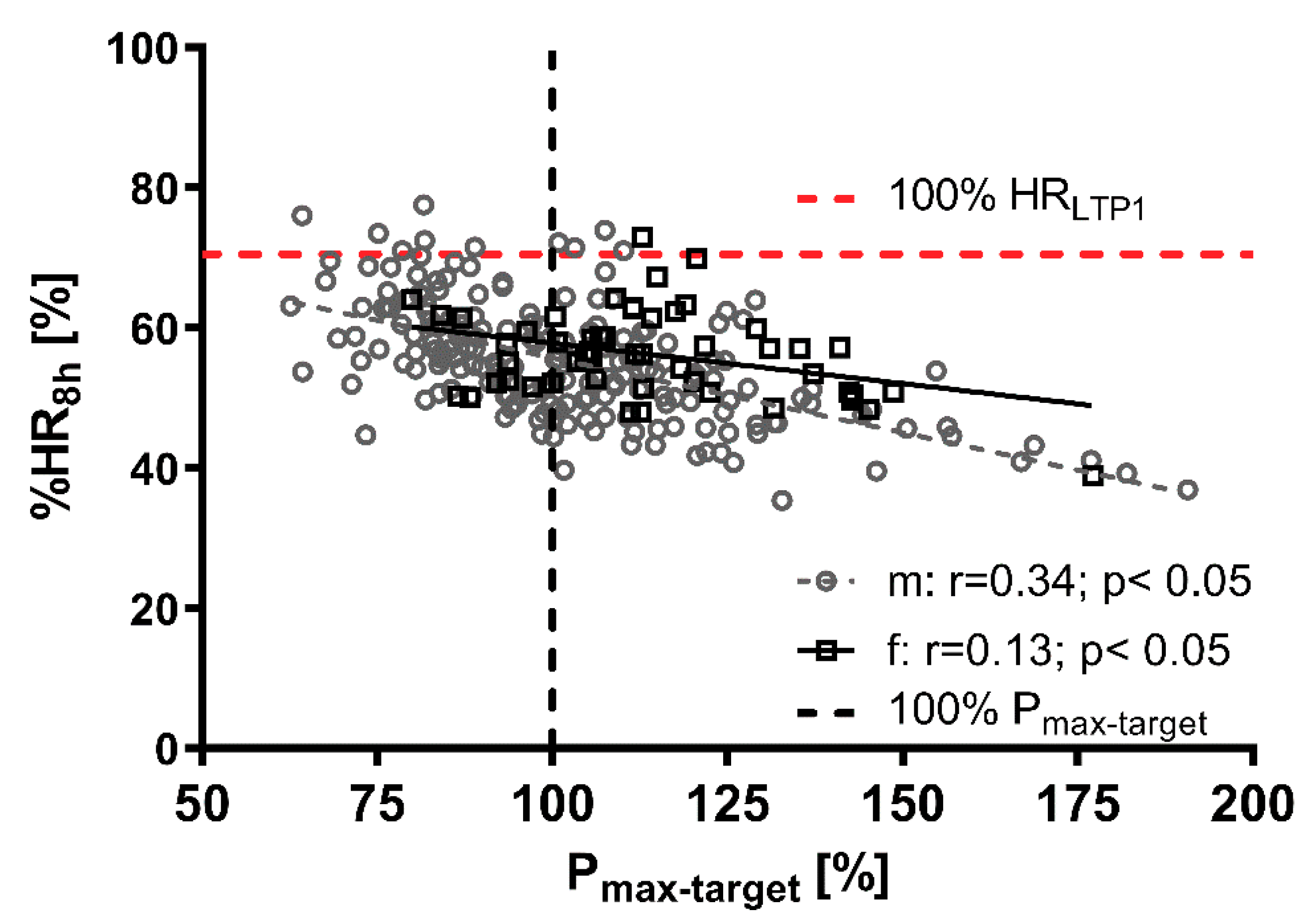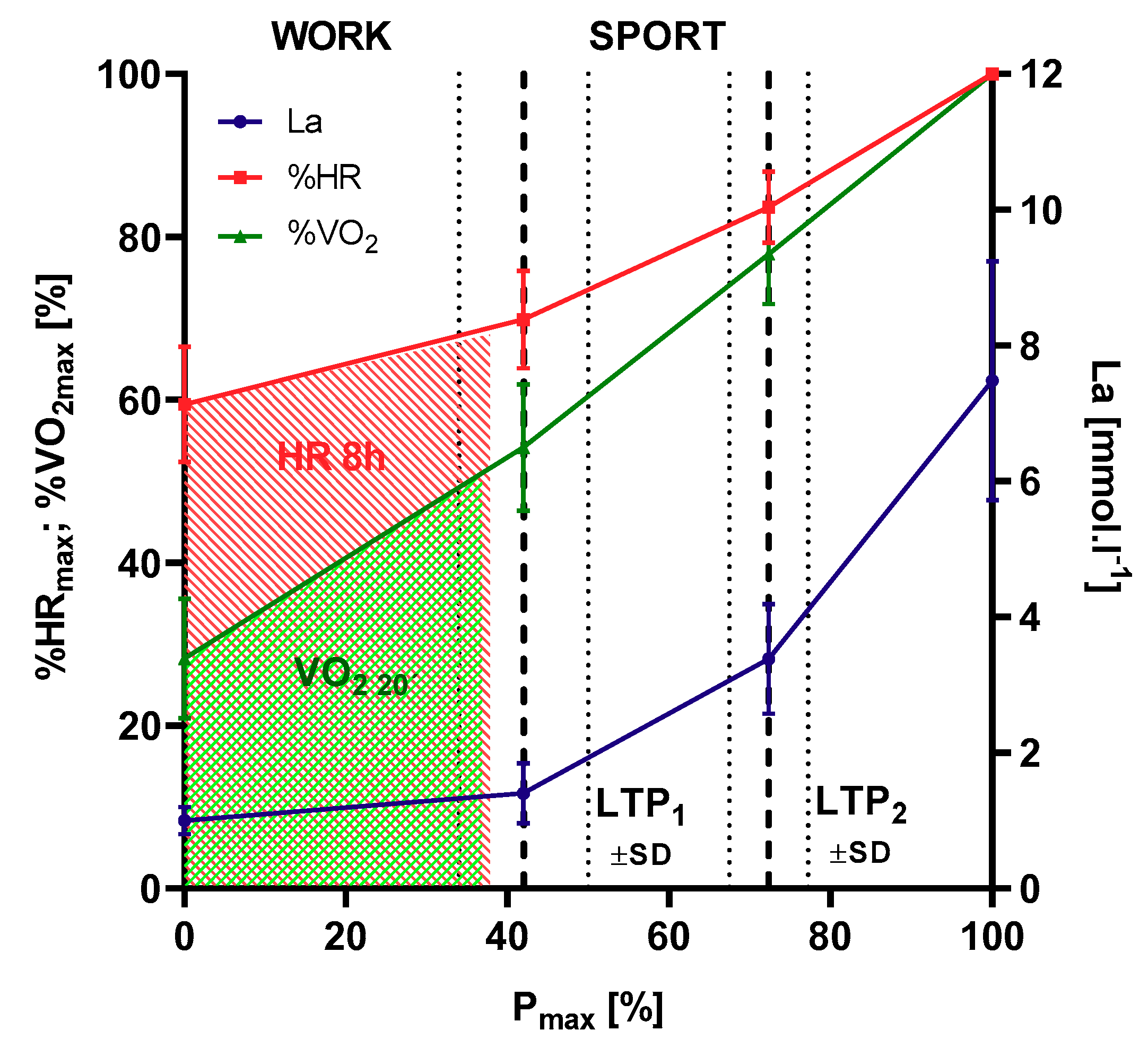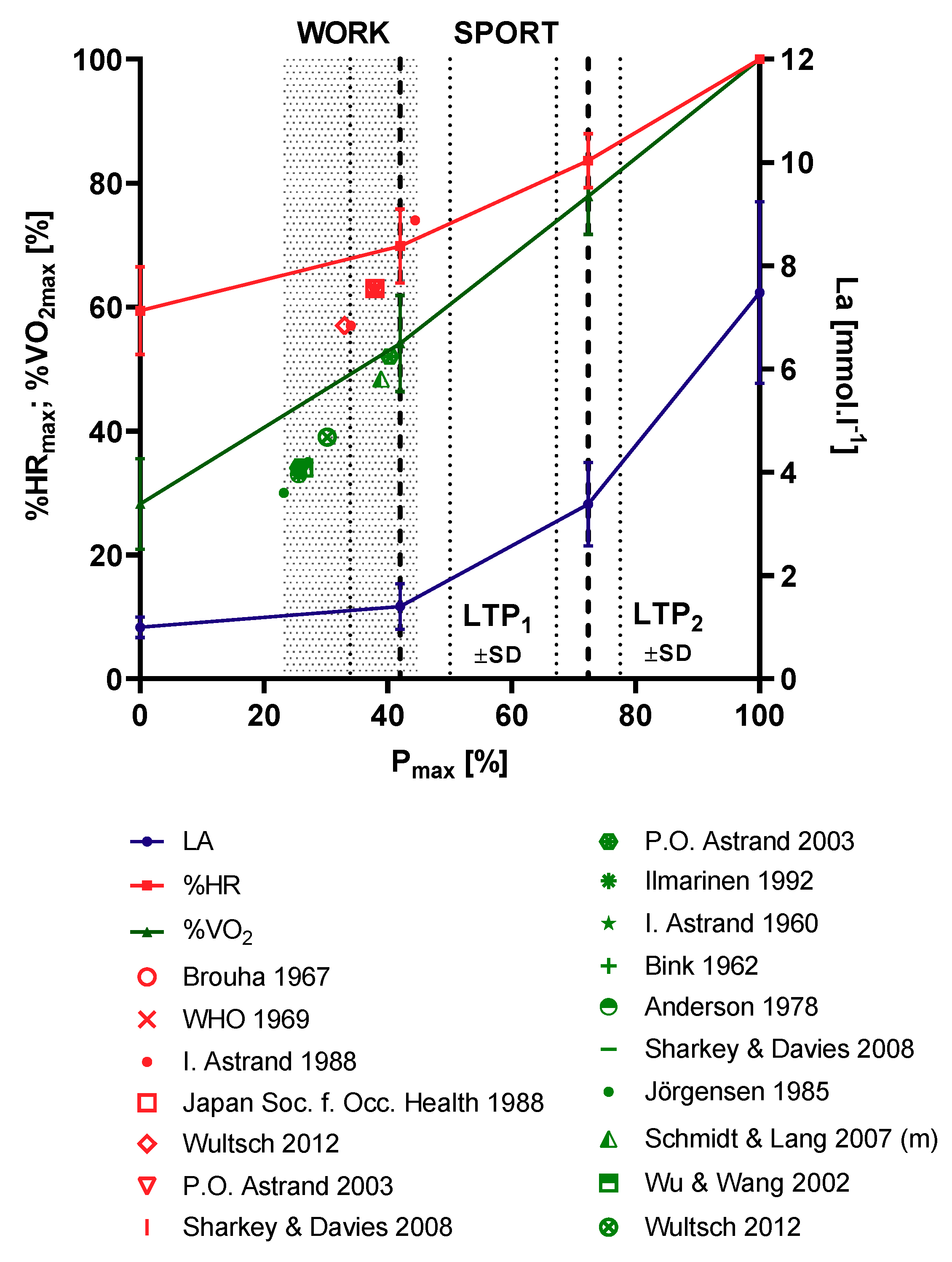The First Lactate Threshold Is a Limit for Heavy Occupational Work
Abstract
1. Introduction
2. Materials and Methods
2.1. Incremental Cycle Ergometer Test
2.2. Measurements during Work
2.3. Statistical Analysis
3. Results
3.1. Incremental Cycle Ergometer Test
3.2. Measurements during Work
4. Discussion
4.1. Measurements during Work
4.2. Oxygen Uptake
4.3. Energy Expenditure
4.4. Further Calculations and Connections
5. Conclusions
Author Contributions
Funding
Acknowledgments
Conflicts of Interest
References
- Robroek, S.J.W.; Reeuwijk, K.G.; Hillier, F.C.; Bambra, C.L.; van Rijn, R.M.; Burdorf, A. The Contribution of Overweight, Obesity, and Lack of Physical Activity to Exit from Paid Employment: A Meta-Analysis. Scand. J. Work Environ. Health 2013, 39, 233–240. [Google Scholar] [CrossRef] [PubMed]
- Holtermann, A.; Marott, J.L.; Gyntelberg, F.; Søgaard, K.; Suadicani, P.; Mortensen, O.S.; Prescott, E.; Schnohr, P. Occupational and Leisure Time Physical Activity: Risk of All-Cause Mortality and Myocardial Infarction in the Copenhagen City Heart Study. A Prospective Cohort Study. BMJ Open 2012, 2, e000556. [Google Scholar] [CrossRef]
- Karpansalo, M.; Lakka, T.; Manninen, P.; Kauhanen, J.; Rauramaa, R.; Salonen, J. Cardiorespiratory Fitness and Risk of Disability Pension: A Prospective Population Based Study in Finnish Men. Occup. Environ. Med. 2003, 60, 765–769. [Google Scholar] [CrossRef] [PubMed]
- Strauss, M.; Foshag, P.; Leischik, R. Prospective Evaluation of Cardiovascular, Cardiorespiratory, and Metabolic Risk of German Office Workers in Comparison to International Data. Int. J. Environ. Res. Public Health 2020, 17, 1590. [Google Scholar] [CrossRef] [PubMed]
- Wultsch, G.; Rinnerhofer, S.; Tschakert, G.; Hofmann, P. Governmental Regulations for Early Retirement by Means of Energy Expenditure Cut Offs. Scand. J. Work Environ. Health 2012, 38, 370–379. [Google Scholar] [CrossRef] [PubMed]
- Krause, N.; Brand, R.J.; Arah, O.A.; Kauhanen, J. Occupational Physical Activity and 20-Year Incidence of Acute Myocardial Infarction: Results from the Kuopio Ischemic Heart Disease Risk Factor Study. Scand. J. Work Environ. Health 2015, 41, 124–139. [Google Scholar] [CrossRef]
- Åstrand, I. Physical Demands in Worklife. Scand. J. Work Environ. Health 1988, 14, 10–13. [Google Scholar]
- Marées, H.; de Heck, H. Sportphysiologie; Sportverlag Strauß: Köln, Germany, 2003. [Google Scholar]
- Tipton, M.J.; Milligan, G.S.; Reilly, T.J. Physiological Employment Standards I. Occupational Fitness Standards: Objectively Subjective? Eur. J. Appl. Physiol. 2013, 113, 2435–2446. [Google Scholar] [CrossRef]
- Åstrand, P.-O. Textbook of Work Physiology: Physiological Bases of Exercise, 4th ed.; Human Kinetics: Champaign, IL, USA, 2003. [Google Scholar]
- Frauendorf, H.; Köhn-Seyer, G.; Gelbrich, W. Heart Rate and Energy Metabolism Response in Selected Physical Tasks in Steel Foundries. Z. Gesamte Hyg. 1981, 27, 30–34. [Google Scholar]
- McEntire, S.J.; Suyama, J.; Hostler, D. Mitigation and Prevention of Exertional Heat Stress in Firefighters: A Review of Cooling Strategies for Structural Firefighting and Hazardous Materials Responders. Prehosp. Emerg. Care 2013, 17, 241–260. [Google Scholar] [CrossRef]
- Preisser, A.M.; Zhou, L.; Garrido, M.V.; Harth, V. Measured by the Oxygen Uptake in the Field, the Work of Refuse Collectors Is Particularly Hard Work: Are the Limit Values for Physical Endurance Workload Too Low? Int. Arch. Occup. Environ. Health 2016, 89, 211–220. [Google Scholar] [CrossRef] [PubMed][Green Version]
- Schlagbauer, D.; Heck, D.; Hofmann, P. Interdisciplinary Research Project: Principles of Work Scheduling. In Proceedings of the Sixth International Structural Engineering and Construction Conference, Zürich, Switzerland, 21–26 June 2011; Volume 2008, pp. 117–122. [Google Scholar]
- Hofmann, P.; von Duvillard, S.P.; Seibert, F.J.; Pokan, R.; Wonisch, M.; Lemura, L.M.; Schwaberger, G. HRmax Target Heart Rate Is Dependent on Heart Rate Performance Curve Deflection. Med. Sci. Sports Exerc. 2001, 33, 1726–1731. [Google Scholar] [CrossRef] [PubMed]
- Binder, R.K.; Wonisch, M.; Corra, U.; Cohen-Solal, A.; Vanhees, L.; Saner, H.; Schmid, J.-P. Methodological Approach to the First and Second Lactate Threshold in Incremental Cardiopulmonary Exercise Testing. Eur. J. Cardiovasc. Prev. Rehabil. 2008, 15, 726–734. [Google Scholar] [CrossRef] [PubMed]
- Hofmann, P.; Tschakert, G. Special Needs to Prescribe Exercise Intensity for Scientific Studies. Cardiol. Res. Pract. 2010, 2011, 209302. [Google Scholar] [CrossRef] [PubMed]
- Wasserman, K.; McIlroy, M.B. Detecting the Threshold of Anaerobic Metabolism in Cardiac Patients during Exercise. Am. J. Cardiol. 1964, 14, 844–852. [Google Scholar] [CrossRef]
- Brooks, G.A. Lactate Shuttles in Nature. Biochem. Soc. Trans. 2002, 30, 258–264. [Google Scholar] [CrossRef]
- Tschakert, G.; Hofmann, P. High-Intensity Intermittent Exercise: Methodological and Physiological Aspects. Int. J. Sports Physiol. Perform. 2013, 8, 600–610. [Google Scholar] [CrossRef]
- Tschakert, G.; Kroepfl, J.; Mueller, A.; Moser, O.; Groeschl, W.; Hofmann, P. How to regulate the acute physiological response to “Aerobic” high-intensity interval exercise. J. Sports Sci. Med. 2015, 14, 29–36. [Google Scholar]
- Moser, O.; Tschakert, G.; Mueller, A.; Groeschl, W.; Hofmann, P.; Pieber, T.; Lawrence, J.; Koehler, G. Short-Acting Insulin Reduction Strategies for Continuous Cycle Ergometer Exercises in Patients with Type 1 Diabetes Mellitus. Asian J. Sports Med. 2017, 8, e42160. [Google Scholar] [CrossRef]
- Hofmann, P.; Tschakert, G. Intensity- and Duration-Based Options to Regulate Endurance Training. Front. Physiol. 2017, 8, 337. [Google Scholar] [CrossRef]
- Cottin, F.; Leprêtre, P.-M.; Lopes, P.; Papelier, Y.; Médigue, C.; Billat, V. Assessment of Ventilatory Thresholds from Heart Rate Variability in Well-Trained Subjects during Cycling. Int. J. Sports Med. 2006, 27, 959–967. [Google Scholar] [CrossRef] [PubMed]
- Barrero, A.; Erola, P.; Bescós, R. Energy Balance of Triathletes during an Ultra-Endurance Event. Nutrients 2014, 7, 209–222. [Google Scholar] [CrossRef] [PubMed]
- Pokan, R.; Ocenasek, H.; Hochgatterer, R.; Miehl, M.; Vonbank, K.; Von Duvillard, S.P.; Franklin, B.; Würth, S.; Volf, I.; Wonisch, M.; et al. Myocardial Dimensions and Hemodynamics during 24-h Ultraendurance Ergometry. Med. Sci. Sports Exerc. 2014, 46, 268–275. [Google Scholar] [CrossRef] [PubMed]
- Kunutsor, S.K.; Kurl, S.; Khan, H.; Zaccardi, F.; Rauramaa, R.; Laukkanen, J.A. Oxygen Uptake at Aerobic Threshold Is Inversely Associated with Fatal Cardiovascular and All-Cause Mortality Events. Ann. Med. 2017, 49, 698–709. [Google Scholar] [CrossRef]
- Wonisch, M.; Berent, R.; Klicpera, M.; Laimer, H.; Marko, C.; Pokan, R.; Schmid, P.; Schwann, H.; Stichwortsuche, A. Praxisleitlinien Ergometrie. Austrian J. Cardiol. 2008, 15, 13. [Google Scholar] [CrossRef]
- Hofmann, P.; Pokan, R.; von Duvillard, S.P.; Seibert, F.J.; Zweiker, R.; Schmid, P. Heart Rate Performance Curve during Incremental Cycle Ergometer Exercise in Healthy Young Male Subjects. Med. Sci. Sports Exerc. 1997, 29, 762–768. [Google Scholar] [CrossRef]
- Beaver, W.L.; Wasserman, K.; Whipp, B.J. A New Method for Detecting Anaerobic Threshold by Gas Exchange. J. Appl. Physiol. 1986, 60, 2020–2027. [Google Scholar] [CrossRef]
- Mifflin, M.D.; St Jeor, S.T.; Hill, L.A.; Scott, B.J.; Daugherty, S.A.; Koh, Y.O. A New Predictive Equation for Resting Energy Expenditure in Healthy Individuals. Am. J. Clin. Nutr. 1990, 51, 241–247. [Google Scholar] [CrossRef]
- Hedges, L.V.; Olkin, I. Statistical Methods for Meta-Analysis; Hedges, L.V., Olkin, I., Eds.; Academic Press: New York, NY, USA, 1985. [Google Scholar]
- World Health Organization. Obesity: Preventing and Managing the Global Epidemic: Report of a WHO Consultation; World Health Organization: Geneva, Switzerland, 2000. [Google Scholar]
- Tammelin, T.; Nayha, S.; Rintamaki, H.; Zitting, P. Occupational Physical Activity Is Related to Physical Fitness in Young Workers. Med. Sci. Sport. Exerc. 2002, 34, 158–165. [Google Scholar] [CrossRef]
- Schibye, B.; Hansen, A.; Søgaard, K.; Christensen, H. Aerobic Power and Muscle Strength among Young and Elderly Workers with and without Physically Demanding Work Tasks. Appl. Ergon. 2001, 32, 425–431. [Google Scholar] [CrossRef]
- World Health Organization. Health Factors Involved in Working under Conditions of Heat Stress. Report of a WHO Scientific Group; Technical Report 412; World Health Organization: Geneva, Switzerland, 1969; pp. 1–32. [Google Scholar]
- Callea, P.; Zimbalatti, G.; Quendler, E.; Nimmerichter, A.; Bachl, N.; Bernardi, B.; Smorto, D.; Benalia, S. Occupational Illnesses Related to Physical Strains in Apple Harvesting. Ann. Agric. Environ. Med. 2014, 21, 407–411. [Google Scholar] [CrossRef] [PubMed]
- Anjos, L.A.; Ferreira, J.A.; Damião, J.J. Heart Rate and Energy Expenditure during Garbage Collection in Rio de Janeiro, Brazil. Cad. Saude Publica 2007, 23, 2749–2755. [Google Scholar] [CrossRef] [PubMed]
- Wakui, T. Study on Work Load of Matrons under Shift Work in a Special Nursing Home for the Elderly. Ind. Health 2000, 38, 280–288. [Google Scholar] [CrossRef] [PubMed]
- Ilmarinen, J.; Tuomi, K. Work Ability of Aging Workers. Scand. J. Work Environ. Health 1992, 18, 8–10. [Google Scholar]
- Rodahl, K.; Vokac, Z.; Fugelli, P.; Vaage, O.; Maehlum, S. Circulatory Strain, Estimated Energy Output and Catecholamine Excretion in Norwegian Coastal Fishermen. Ergonomics 1974, 17, 585–602. [Google Scholar] [CrossRef]
- Åstrand, I.; Fugelli, P.; Karlsson, C.G.; Rodahl, K.; Vokac, Z. Energy Output and Work Stress in Coastal Fishing. Scand. J. Clin. Lab. Investig. 1973, 31, 105–113. [Google Scholar]
- Dennison, K.J.; Mullineaux, D.R.; Yates, J.W.; Abel, M.G. The Effect of Fatigue and Training Status on Firefighter Performance. J. Strength Cond. Res. 2012, 26, 1101–1109. [Google Scholar] [CrossRef]
- Smith, D.L. Firefighter Fitness: Improving Performance and Preventing Injuries and Fatalities. Curr. Sports Med. Rep. 2011, 10, 167–172. [Google Scholar] [CrossRef]
- Lindberg, A.-S.; Oksa, J.; Gavhed, D.; Malm, C. Field Tests for Evaluating the Aerobic Work Capacity of Firefighters. PLoS ONE 2013, 8, e68047. [Google Scholar] [CrossRef]





| Variables | Female Workers | Male Workers | p-Value | Mean Diff. (95% CI) | g |
|---|---|---|---|---|---|
| N | 52 | 188 | – | – | |
| Age (yrs) | 34.5 ± 10.6 | 34.9 ± 10 | 0.3 | −2.67 (−7.79 to 2.45) | 0.04 |
| Height (cm) | 165 ± 6 | 178.3 ± 6.4 | <0.0001 | 0.12 (0.1 to 0.15) | 2.11 |
| Weight (kg) | 65.3 ± 13 | 82.1 ± 10 | <0.0001 | −14.09 (−20.18 to −8.01) | 1.57 |
| BMI (kg/m2) | 23.9 ± 4.3 | 25.8 ± 4.2 | 0.12 | 1.32 (−0.38 to 3.02) | 0.45 |
| Variables | Female Workers | Male Workers | p-Value | Mean Diff. (95% CI) | g |
|---|---|---|---|---|---|
| Pmax (W) | 150.0 ± 30.8 | 217.6 ± 48.2 | <0.0001 | 67.65 (56.69 to 78.60) | 1.50 |
| % Pmax-target (%) | 113.9 ± 19.4 | 102.5 ± 23.1 | 0.0006 | −11.33 (−17.63 to −5.02) | −0.51 |
| VO2 max (L·min−1) | 1.94 ± 0.44 | 2.90 ± 0.60 | <0.0001 | 0.96 (0.82 to 1.11) | 1.69 |
| VO2 max rel. (mL·kg−1) | 30.3 ± 7 | 36.0 ± 8.2 | <0.0001 | 5.72 (3.46 to 7.97) | 0.72 |
| % VO2 max-target (%) | 121.4 ± 17.5 | 114.2 ± 11.7 | 0.01 | −7.18 (−12.33 to −2.04) | −0.55 |
| HRmax (b·min−1) | 177.6 ± 16.1 | 176.4 ± 14.2 | 0.63 | −1.18 (−9.09 to 3.74) | −0.08 |
| % HRmax-target (%) | 93.6 ± 8.8 | 94.8 ± 7.2 | 0.38 | 1.17 (−1.46 to 3.81) | 0.16 |
| Lamax (mmol·L−1) | 6.99 ± 1.47 | 7.62 ± 1.81 | 0.01 | 0.63 (0.14 to 1.11) | 0.36 |
| RERmax | 1.20 ± 0.11 | 1.21 ± 0.10 | 0.65 | 0.01 (−0.03 to 0.04) | 0.1 |
| Variables | Female Workers | Male Workers | p-Value | Mean Diff. (95% CI) | g |
|---|---|---|---|---|---|
| PLTP1 (W) | 58.4 ± 14.8 | 94.1 ± 30.5 | <0.0001 | 35.74 (29.58 to 41.91) | 1.28 |
| % Pmax (%) | 38.9 ± 7.4 | 42.8 ± 8.0 | 0.001 | 3.9 (1.55 to 6.25) | 0.5 |
| VO2 LTP1 (L·min−1) | 1.09 ± 0.22 | 1.54 ± 0.37 | <0.0001 | 0.45 (0.37 to 0.53) | 1.31 |
| % VO2 max (%) | 57.0 ± 8.1 | 53.3 ± 7.4 | 0.004 | −3.71 (−6.21 to −1.21) | −0.49 |
| HRLTP1 (b·min−1) | 127.4 ± 16.7 | 122.1 ± 12.4 | <0.05 | −5.39 (−10.36 to −0.42) | −0.39 |
| % HRmax (%) | 71.7 ± 5.7 | 69.3 ± 6.0 | <0.0001 | −15.83 (−16.89 to −14.78) | −0.4 |
| LaLTP1 (mmol·L−1) | 1.34 ± 0.45 | 1.42 ± 0.44 | 0.26 | 0.08 (−0.06 to 0.22) | 0.18 |
| PVT1 (W) | 60.8 ±17.3 | 98.2 ± 31.6 | <0.0001 | 37.45 (30.76 to 44.14) | 1.28 |
| % Pmax (%) | 40.5 ± 8.1 | 44.5 ± 7.9 | <0.001 | 4.50 (1.97 to 7.04) | 0.5 |
| VO2 VT1 (L·min−1) | 1.10 ± 0.25 | 1.58 ± 0.38 | <0.0001 | 0.48 (0.39 to 0.57) | 1.35 |
| % VO2 max (%) | 57.0 ± 7.9 | 54.7 ±5.3 | 0.06 | −2.30 (−4.75 to 0.14) | −0.39 |
| HRVT1 (b·min−1) | 127.7 ± 16.3 | 123.4 ± 11.9 | 0.08 | −4.30 (−9.17 to 0.57) | −0.33 |
| % HRmax (%) | 71.8 ± 5.4 | 70.1 ± 5.3 | <0.05 | −1.74 (−3.42 to −0.06) | −0.32 |
| LaVT1 (mmol·L−1) | 1.55 ± 0.50 | 1.64 ± 0.41 | 0.25 | 0.09 (−0.07 to 0.25) | 0.21 |
| Variables | Female Workers | Male Workers | p-Value | Mean Diff. (95% CI) | g |
|---|---|---|---|---|---|
| HR8h (b·min−1) | 99.3 ± 10.0 | 96.9 ± 14.1 | 0.17 | −2.41(−5.84 to 1.09) | −0.18 |
| % HRLTP1 (%) | 78.9 ± 10.2 | 79.9 ± 12.1 | 0.52 | 1.07(−2.24 to 4.38) | 0.09 |
| % HRmax (%) | 56.2 ± 6.2 | 55.2 ± 8.5 | 0.33 | −1.03 (−3.14 to 1.08) | −0.12 |
| HR20 (b·min−1) | 101.0 ± 12.1 | 100.2 ± 16.0 | 0.71 | −0.75 (−4.82 to 3.32) | −0.05 |
| % HRLTP1 (%) | 80.1 ± 11.5 | 82.7 ± 13.8 | 0.18 | 2.54 (1.20 to 6.27) | 0.20 |
| % HRmax (%) | 57.2 ± 7.6 | 57.1 ± 9.5 | 0.92 | −0.12 (−2.63 to 2.39) | −0.01 |
| VO2 20 (L·min−1) | 0.72 ± 0.25 | 1.00 ± 0.30 | <0.0001 | 0.28(0.20 to 0.36) | 1.00 |
| % VO2 LTP1 (%) | 67.4 ± 23.9 | 67.9 ± 26.3 | 0.89 | 0.54 (−7.10 to 8.17) | 0.02 |
| % VO2 max (%) | 37.8 ± 12.3 | 35.3 ± 11.5 | 0.19 | −2.51 (−6.30 to 1.28) | −0.21 |
| EEr24h (kcal) | 1366 ± 174 | 1766 ± 154 | <0.0001 | 400 (347 to 453) | 2.52 |
| EE8h (kcal) | 1639 ± 537 | 2249 ± 691 | <0.0001 | 610 (431 to 789) | 0.92 |
| MET8h (EE) | 25.2 ± 6.9 | 27.8 ± 8.9 | <0.05 | 2.57 (0.27 to 4.87) | 0.31 |
| WEE8h (kcal) | 1184 ± 518 | 1660 ± 677 | <0.0001 | 477 (304 to 650) | 0.74 |
| MET8h (WEE) | 25.21 ± 6.91 | 27.78 ± 8.87 | <0.05 | 2.57 (0.27 to 4.86) | 0.3 |
| MET1h (WEE) | 3.15 ± 0.86 | 3.47 ± 1.11 | <0.05 | 0.30 (0.01 to 0.59) | 0.3 |
© 2020 by the authors. Licensee MDPI, Basel, Switzerland. This article is an open access article distributed under the terms and conditions of the Creative Commons Attribution (CC BY) license (http://creativecommons.org/licenses/by/4.0/).
Share and Cite
Fasching, P.; Rinnerhofer, S.; Wultsch, G.; Birnbaumer, P.; Hofmann, P. The First Lactate Threshold Is a Limit for Heavy Occupational Work. J. Funct. Morphol. Kinesiol. 2020, 5, 66. https://doi.org/10.3390/jfmk5030066
Fasching P, Rinnerhofer S, Wultsch G, Birnbaumer P, Hofmann P. The First Lactate Threshold Is a Limit for Heavy Occupational Work. Journal of Functional Morphology and Kinesiology. 2020; 5(3):66. https://doi.org/10.3390/jfmk5030066
Chicago/Turabian StyleFasching, Patrick, Stefan Rinnerhofer, Georg Wultsch, Philipp Birnbaumer, and Peter Hofmann. 2020. "The First Lactate Threshold Is a Limit for Heavy Occupational Work" Journal of Functional Morphology and Kinesiology 5, no. 3: 66. https://doi.org/10.3390/jfmk5030066
APA StyleFasching, P., Rinnerhofer, S., Wultsch, G., Birnbaumer, P., & Hofmann, P. (2020). The First Lactate Threshold Is a Limit for Heavy Occupational Work. Journal of Functional Morphology and Kinesiology, 5(3), 66. https://doi.org/10.3390/jfmk5030066






